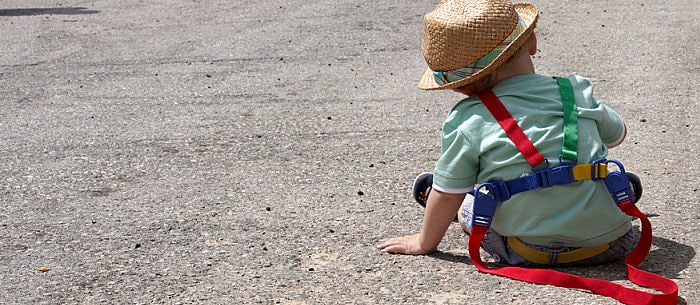Before you had kids, you saw parents using a toddler leash and thought it looked a little strange. Now that you’ve got a very active little one of your own, using a harness is looking like a pretty good idea — especially for that upcoming trip to Disneyland.
However, if you’re still feeling a bit hesitant about the whole idea, read on as two parenting educators weigh in on the pros and cons of using a toddler leash. Pattie Fitzgerald, a child safely educator and founder of Safely Ever After, and parenting blogger, educator and home day care provider Melody Altamura, discuss when using a leash may be appropriate and offer some alternatives for keeping track of children in a crowd.
The Pros and Cons of Using a Toddler Leash
“One of the pros of using it is definitely that it gives parents a sense of security and allows them to stay in control,” says Fitzgerald. It’s all about parents being able to keep their sanity and reduce some of the stress of being out about in crowds with small children. “There’s nothing more terrifying than not being able to find your child,” she continues. “Another upside is that kids tend to like it, especially when it’s shaped like a furry animal or fun cartoon character. They think it’s fun.”
Though you might find a toddler leash useful, you’ll likely meet other parents who disagree. Fitzgerald believes that the only negative to using a toddler harness is dealing with the judgmental looks or snarky comments. This is something that Altamura can relate to. “I’ve gotten raised eyebrows and even nasty looks when people have seen me using my harness,” she says. “It can be annoying dealing with that, but for me, safety comes first,” she continues.
The Best Way to Use a Toddler Leash
Fitzgerald suggests that the best way to use a toddler harness is to think of it like a stroller. “People don’t think ‘oh, I’m treating my child like an invalid!’ when they use strollers. They see it as necessary,” she explains. She also recommends that people stop calling the toddler harness a leash. “Kids are not dogs, so I prefer to call the device a tether instead of a leash or harness.”
Altamura stresses that “it’s important to talk with your child and let them know that the reason they’re wearing the tether is for safety. This may help to keep melt-downs about wearing one to a minimum.”
It’s important to do your research before buying a tether. “Buy the correct size and a good quality product,” says Fitzgerald. “Also, always double check the clips to ensure that they’re clasped securely.” Additionally, she cautions against using the tether too roughly, which may cause abrasions or irritate your child’s skin.
Other Options to Control a Running Tot
Not sold on the toddler leash idea? Using other ways to track your child, especially in a crowd, can be exhausting, advises Fitzgerald. But for those up for the challenge, here are some alternatives to using a tether:
- Make Staying in Sight a Game
“An example would be telling the child that they can only be three steps ahead of you or they lose the game,” explains Fitzgerald. “The idea is to make it fun.”
- Have Kids Wear Bright, Memorable Clothes
This will help your kid to stand out and make it easier to track him.
- Give Your Child a Job to Do
For example, put your child in charge of doing headcounts or being on the lookout for restrooms or stores that have a certain thing, like water and napkins. This way, your child stays focused and is less likely to distractedly wander off.
- Set Up a Rule to Always “Check First”
“With this rule,” says Fitzgerald, “have the child say something like ‘I’m going to look at those toys.'” She adds that “Parents should also follow the ‘check first’ rule to help get kids in the habit. Say ‘Mommy’s going to look at this dress, okay?’ and have the child follow along.”
- Hold Hands and Engage Your Kid in Conversation
Many kids are used to doing this every day, but in a large crowd, the conversation and engagement needs to be more constant.
Tisha Berg has been a freelance content writer and desktop publisher since 1997, with articles on family life, healthy living and parenting appearing on Working Mother, AboutOne, Lifescript and United Way. Tisha holds a bachelor’s degree in theater history from Hunter College in New York City and is also certified hypnotherapist.





